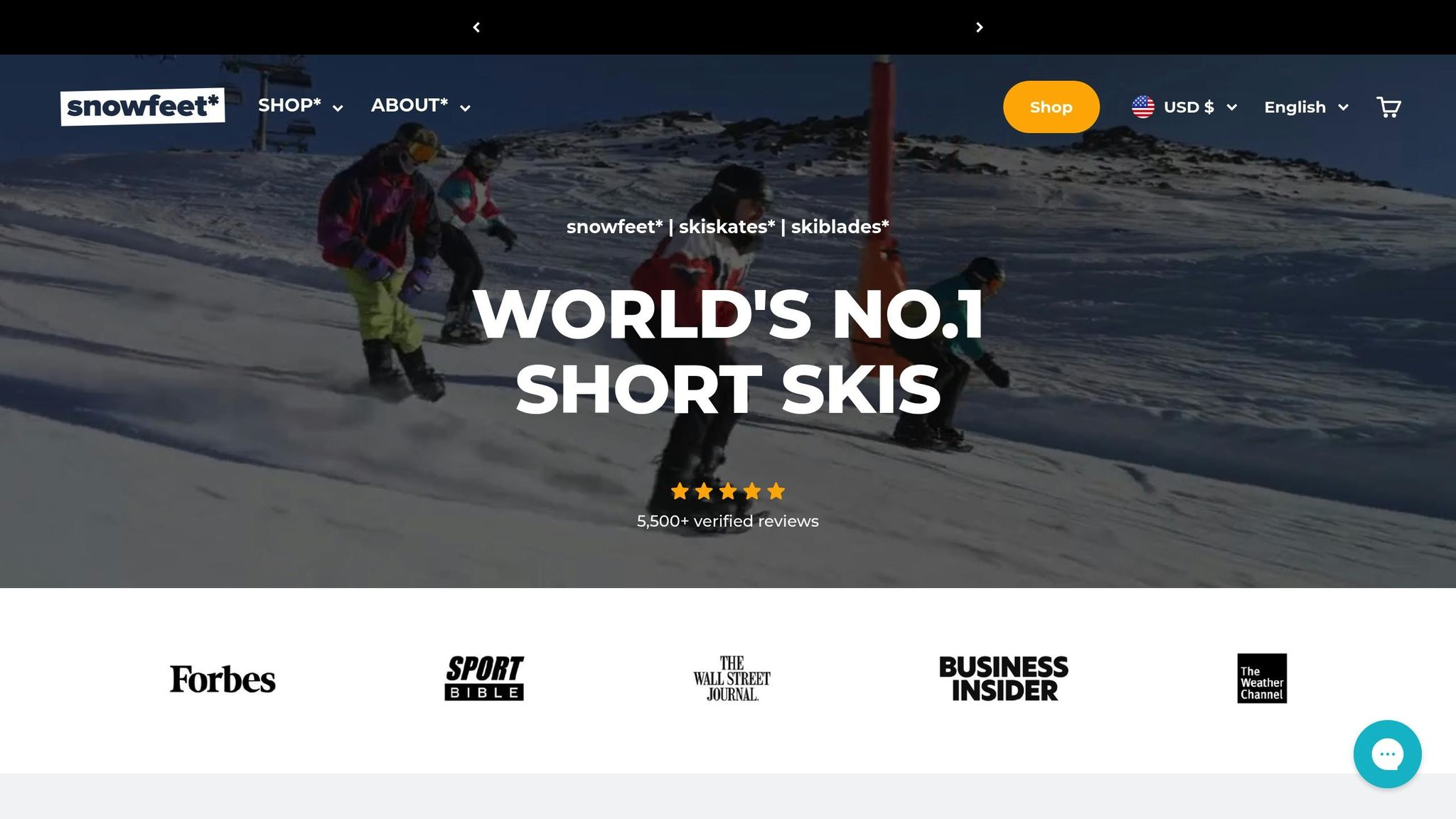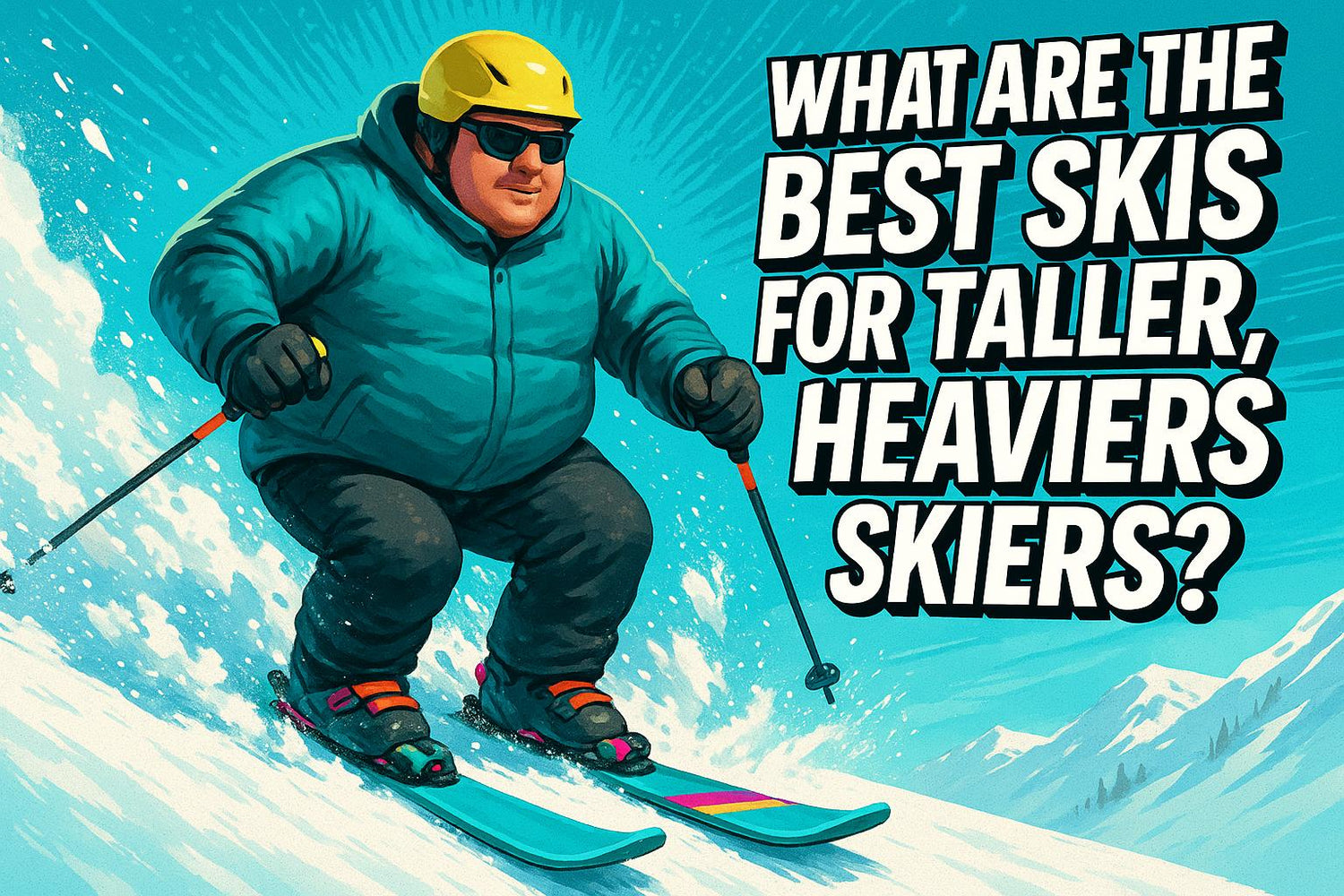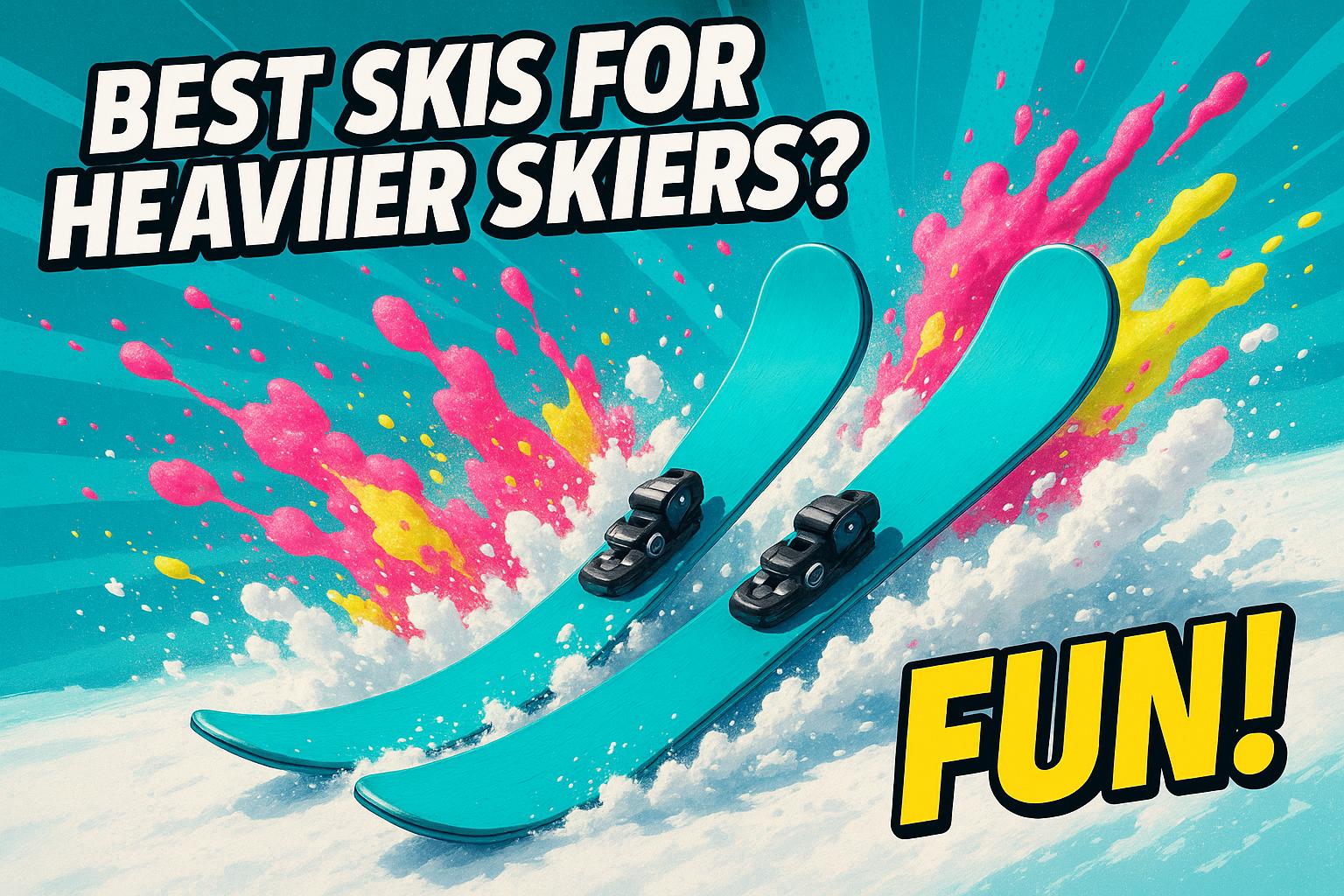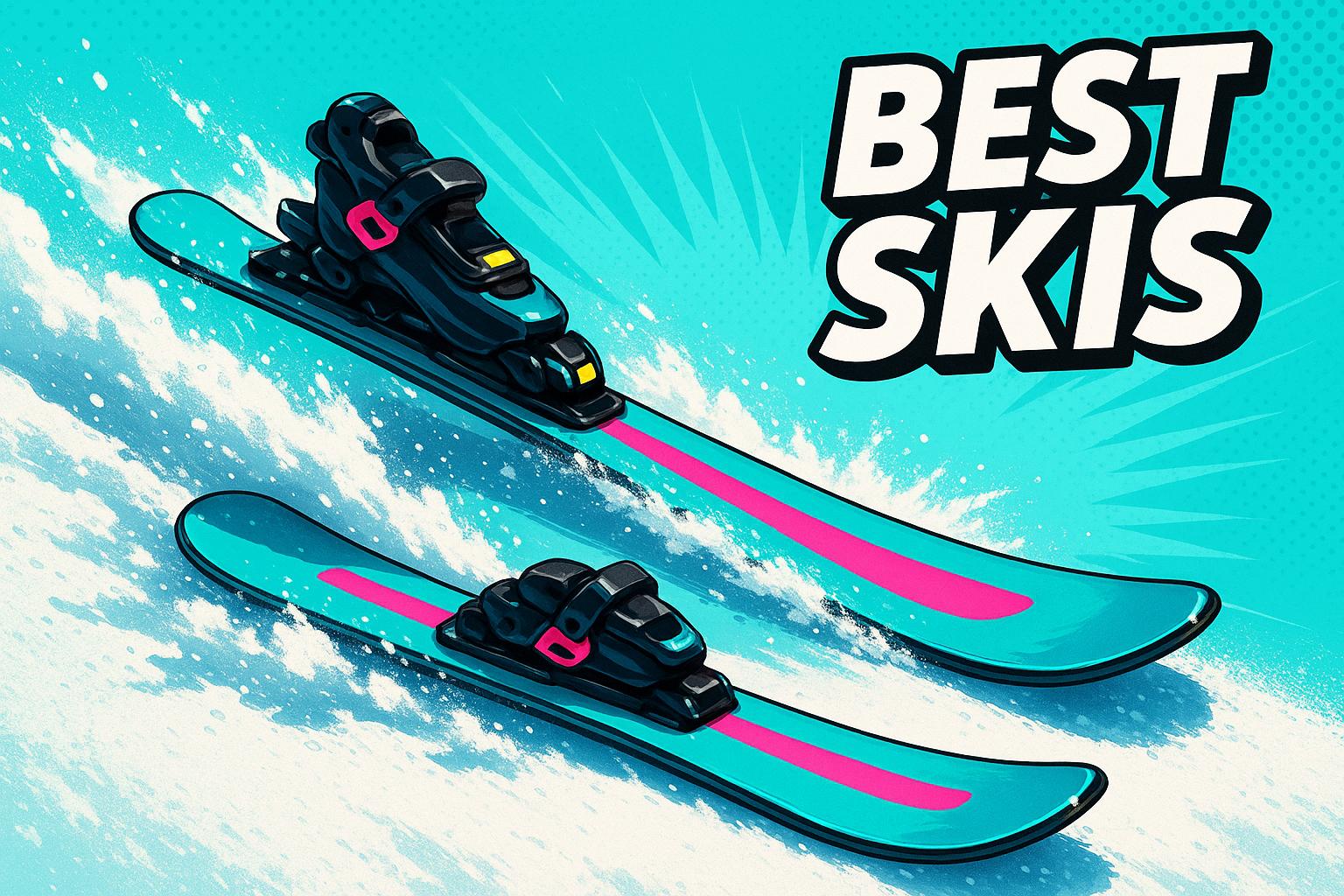If you're a taller or heavier skier, dealing with long, bulky skis can feel like a workout - and not the fun kind. The good news? Shorter skis like Snowfeet Skiblades and Skiskates are changing the game. They're lightweight, easier to control, and still provide solid support for bigger skiers.
Here’s the quick breakdown:
- Snowfeet Skiblades (26–47 inches): Great for stability, carving, and all-mountain fun. The 120 cm (47-inch) model is best for balance and speed, while shorter options (26–39 inches) focus on agility and sharp turns.
- Snowfeet Skiskates (17 inches): Think skiing meets skating. Perfect for playful moves, quick turns, and easy transport (they fit in a backpack!).
Both options work well on groomed runs and in terrain parks, but Skiblades handle powder better. If you’re tired of wrestling with long skis, these compact options make skiing easier and way more enjoyable. Prices start around $390 for Skiskates and $450 for Skiblades.
Key takeaway: For stability and speed, go Skiblades. For portability and fun, try Skiskates. Either way, you’ll spend less time struggling and more time enjoying the slopes. :)
Short Skis vs. Long Skis
1. Snowfeet* Skiblades (65 cm, 99 cm, 120 cm)

Snowfeet* Skiblades come in three lengths, catering to taller and heavier skiers. These compact alternatives to traditional skis offer a fresh take on winter sports, combining control, support, and versatility in a smaller package.
Stability and Support
The 120 cm (47 inch) Skiblades are the go-to choice for skiers who need maximum stability. Their wider profile and reinforced build spread weight evenly, reducing the chances of edge catches and improving balance at higher speeds. This length is perfect for carving and offers excellent front-to-back support.
The 99 cm (39 inch) model strikes a balance between stability and agility. It offers enough support for heavier skiers while maintaining a smooth carving experience. If you're over 200 lbs, this length provides a comfortable mix of control and maneuverability, making it feel similar to regular skis but with added ease of use.
The 65 cm (26 inch) option is all about quick, sharp movements. While it requires more balance, its wider waist and durable materials ensure it can handle heavier users without excessive flexing. It’s a fun and responsive choice for those who enjoy fast, dynamic skiing.
Maneuverability
When it comes to agility, Snowfeet* Skiblades shine. The 65 cm model is the most nimble, perfect for quick turns, tight spaces, and playful movements - ideal for terrain parks or skiers who like to mix things up.
The 99 cm and 120 cm models offer a great mix of stability and maneuverability. They make edge-to-edge transitions feel smooth and effortless, unlike the more demanding movements required with traditional longer skis. Whether you're weaving through trees or carving on open slopes, these Skiblades provide a fun and easy ride.
Portability
One of the biggest perks of Snowfeet* Skiblades is how easy they are to transport. The 120 cm model, though the longest, is still much shorter and lighter than standard skis. They can fit in a regular car without needing roof racks or extra modifications. This compact design not only makes travel simpler but also reduces fatigue when carrying them between runs or through crowded areas.
Terrain Options
Snowfeet* Skiblades are built for versatility, performing well across various terrains. On groomed runs, their sturdy construction and wide base ensure a solid edge grip and smooth ride, even on firm snow.
In terrain parks, the shorter lengths make tricks and quick maneuvers a breeze. The 65 cm model, with its skate-like feel, is particularly suited for jumps and fast movements, while the 99 cm and 120 cm options provide the stability needed for rails and larger features.
For moderate off-piste adventures, the wider profile of these Skiblades helps with flotation in softer snow. The 99 cm model, in particular, handles powder conditions well, offering a great mix of control and performance. Heavier skiers will appreciate the reinforced bindings and stiffer flex, which keep the Skiblades responsive and supportive, even in challenging conditions.
Whether you're carving on groomed trails, hitting the terrain park, or exploring off-piste, Snowfeet* Skiblades bring a fun, easy-to-handle experience to the slopes. They pack the versatility of traditional skis into a much smaller, more portable design.
2. Snowfeet* Skiskates (44 cm)
At just 17 inches (around 44 cm) in length, Snowfeet* Skiskates bring a fresh twist to skiing. Blending the best of skiing and skating, these compact skates offer a unique option for taller or heavier skiers. Let’s dive into what makes them stand out in terms of stability, maneuverability, and portability.
Stability and Support
Don’t let their size fool you - Skiskates pack a punch when it comes to stability. Thanks to their parabolic shape and narrow waist, they provide solid support even for heavier skiers. The wood core construction, similar to traditional skis, minimizes flex under pressure, making them surprisingly reliable.
If you’ve ever ice skated or rollerbladed, you might find Skiskates easier to pick up than traditional skis. The skating-like motion feels natural, and their shorter length reduces the leverage that can make balancing on longer skis tricky. This means you get quick responsiveness without the steep learning curve that often comes with full-length skis.
Maneuverability
When it comes to maneuverability, Skiskates are in a league of their own. Their compact size makes them incredibly agile, allowing for quick, sharp turns and effortless carving. Think of it like dancing on snow - they’re that responsive.
Their design also encourages creativity. Whether you’re into jumps, twists, or tricks, Skiskates make it easier to experiment with moves that would be tough - or downright impossible - with traditional skis. Every run feels lively and energetic, offering a playful alternative to the more calculated approach required by longer skis.
Portability
One of the biggest perks of Skiskates is how easy they are to carry around. At just 44 cm, they can fit into a standard backpack. That’s right - no need for bulky ski bags, roof racks, or extra gear. Whether you’re heading out for a quick session or a day at the slopes, their portable size makes them a hassle-free choice.
Terrain Options
Skiskates shine on groomed snow, slopes, and snow parks. Their compact design even lets you explore narrow trails that would be tricky - or outright inaccessible - with longer skis.
In terrain parks, they’re a game-changer. Their short length makes them perfect for tight spaces, rails, and other park features, offering something for everyone - whether you’re a beginner, intermediate, or seasoned pro.
However, they’re not ideal for deep powder or backcountry conditions, where longer skis provide better floatation. But for resort runs and park adventures, Skiskates deliver a unique mix of fun, freedom, and versatility that traditional skis just can’t match.
Pros and Cons
Deciding between Snowfeet Skiblades and Skiskates? Understanding their strengths and limitations can help you choose the right match for your style and needs. Here's a side-by-side comparison of these fun alternatives to traditional long skis:
| Feature | Snowfeet Skiblades (65–120 cm)* | Snowfeet Skiskates (44 cm)* |
|---|---|---|
| Stability | Offers solid stability, especially for taller or heavier skiers | Surprisingly stable despite their small size |
| Learning Curve | Easy to pick up, with a natural feel that's simpler than traditional skis | Very beginner-friendly with a movement similar to skating |
| Maneuverability | Sharp turns and responsive carving thanks to their agile build | Extremely nimble, almost like dancing on snow |
| Portability | Compact enough to fit in most ski bags | Ultra-portable - fits in a standard backpack |
| Terrain Versatility | Performs well on groomed runs, powder, and mixed conditions | Best for groomed slopes and terrain parks |
| Speed Potential | Longer models (99–120 cm) allow for higher speeds with good control | Prioritizes playful, controlled motion over raw speed |
| Trick Capability | Great for park features, jumps, and freestyle moves | Perfect for spins, tricks, and creative maneuvers |
| Price Range | Roughly $450–$690, depending on the length | Starts at around $390 |
Now, let’s break it down further. Skiblades, with their range of sizes (99–120 cm), give taller and heavier skiers the confidence to handle higher speeds while staying in control - something that can be tricky with traditional skis that often measure 170 cm or longer. On the other hand, Skiskates bring unmatched convenience. Their compact size means you can toss them in a standard backpack - no need for bulky ski bags or roof racks.
What About Limitations?
While both options are much easier to use than traditional skis, there are a few things to keep in mind. Skiblades, though compact compared to long skis, still need standard ski bags for transport. Skiskates, while incredibly portable, perform best on groomed terrain and aren't ideal for deep powder.
But here’s the big win: both products address a common struggle for taller and heavier skiers - the sheer effort it takes to control traditional long skis. Whether you’re hitting technical park features or tackling tricky routes, Snowfeet gear makes it all more accessible. These options open up new possibilities for skiers of all skill levels, making the slopes more fun and less exhausting.
sbb-itb-17ade95
Conclusion
For taller or heavier skiers tired of dealing with bulky, complicated long skis, Snowfeet offers a refreshing alternative. Their short skis and skates provide solid support and easy maneuverability across different terrains. Whether you're carving smooth turns on groomed runs or tackling mixed conditions, these compact options deliver great performance without the hassle of oversized gear - and at a competitive price point.
Choosing between Skiblades and Skiskates comes down to your skiing style and what matters most to you. If you're after versatility and stability at higher speeds, the Snowfeet Skiblades in 99 cm or 120 cm lengths strike a great balance between control and agility. On the other hand, if portability and a fun, playful ride are your top priorities, the 44 cm Skiskates are perfect. They're easy to pack and still offer reliable stability on groomed slopes.
What sets Snowfeet apart from brands like Rossignol, Salomon, or K2 is their shorter, more user-friendly design. Instead of wrestling with heavy skis that require pinpoint technique, Snowfeet gear works naturally with your movements, making it especially appealing for taller skiers who often struggle with traditional setups. This thoughtful approach makes Snowfeet a standout choice for skiers of all levels.
With Snowfeet, you’ll spend less time wrestling with equipment and more time enjoying the slopes. Their products address the control and fatigue issues that can make traditional long skis a challenge, especially for bigger skiers.
Whether you go for the 65 cm Skiblades as a beginner, the 99–120 cm models for all-mountain adventures, or the ultra-portable 44 cm Skiskates, you’re choosing gear that makes skiing easier and more enjoyable. It’s skiing, simplified.
FAQs
Which is easier for beginners: Snowfeet Skiblades or Skiskates?
Skiblades vs. Skiskates: Which Is Better for Beginners?
If you're new to snow sports, both Snowfeet Skiblades and Skiskates are great options, but Skiskates take the lead when it comes to ease of use. Their compact size - just 44 cm - makes them super easy to maneuver and keeps you feeling stable, especially at slower speeds. This makes them perfect for anyone just starting out.
Skiblades, on the other hand, come in longer sizes ranging from 65 cm to 120 cm. They’re still beginner-friendly but offer more versatility and control as your skills improve. That said, they might feel a bit trickier to handle at higher speeds compared to Skiskates.
If you're looking for something lightweight, simple, and beginner-focused, Skiskates are the way to go. They offer a fun and approachable way to dive into snow sports - without the steep learning curve of traditional skis or snowboards.
Why are Snowfeet Skiblades and Skiskates a better choice than traditional long skis for taller and heavier skiers?
Why Snowfeet Skiblades and Skiskates Are a Game-Changer for Larger Skiers
Snowfeet Skiblades and Skiskates bring a fresh twist to hitting the slopes, especially for taller or heavier skiers. Their shorter length makes them much easier to handle, giving you better control and cutting down the learning curve. Plus, you can say goodbye to the awkward, bulky feel of traditional long skis - these are all about agility and ease.
Another big win? Their lightweight design. This means less strain on your legs, so you can enjoy longer runs without feeling wiped out. And don’t let their size fool you - thanks to fiberglass-reinforced construction, they’re tough, stable, and built to last.
For skiers who need extra support and control, these features make Snowfeet Skiblades and Skiskates a safer and more enjoyable option. They’re modern, hassle-free, and designed to keep you comfortable and confident on the mountain.
Are there certain terrains or conditions where Snowfeet Skiblades or Skiskates aren’t ideal?
Snowfeet Skiblades and Skiskates are all about agility, fun, and simplicity. They're a great fit for groomed slopes, terrain parks, and laid-back skiing adventures. But if you're tackling long, fast downhill runs or icy, steep slopes, they might not be your best bet. Their shorter length makes them super easy to maneuver, but it comes at the cost of the stability you'd get with traditional skis in those tougher conditions.
Another thing to keep in mind: Snowfeet products are specifically designed to work with certain boot and binding setups. This means they aren't as versatile as traditional skis, which can pair with a wider variety of gear. That said, they’re lightweight, easy to carry, and perfect for anyone looking for a playful, one-of-a-kind skiing experience. Just know they shine in casual settings rather than high-speed or extreme ones.


































Leave a comment
This site is protected by hCaptcha and the hCaptcha Privacy Policy and Terms of Service apply.